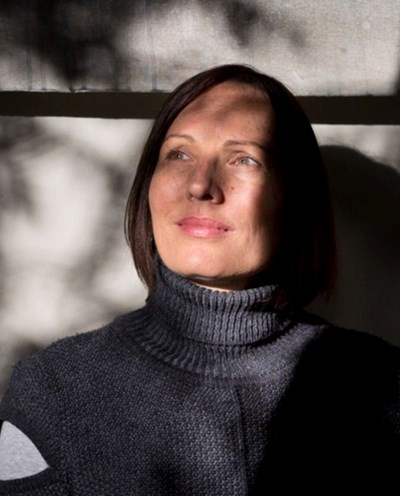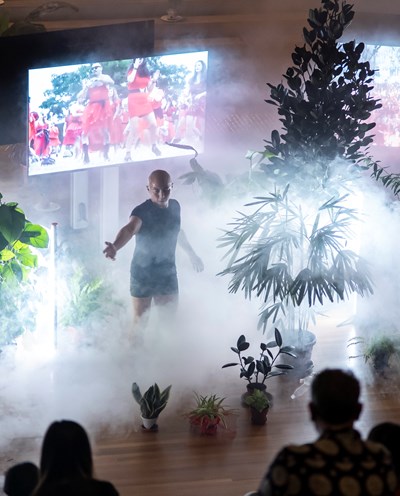
Interview with Alex Wisser

Alex Wisser is a self-proclaimed artshole working as an artist, curator, festival director in Kandos, regional NSW. His practice involves large scale, long term projects within a cross disciplinary, community engaged practice exploring the potential of art to participate in everyday cultural contexts. Alex has curated LIVE DREAMS: CLOISTERED as part of Liveworks 2022, so we sat down with the man of many hats and talents to learn more about his practice.
How do you balance being an artist and a creative director/curator? How do the two roles influence each other?
The way I think about category is that it is a line we draw arbitrarily across a spectrum of a phenomena. So if you take that line out that divides an artist and a curator, the line is very blrury already, but if you can take it out and think about it without a line between the two. Really, there is no difference. We are basically engaged in the same activity - the making and exhibition of work. And all of that is part of the creative process, the same creative process. I guess to go back on that, the line is still necessary. We don’t have that line there for no reason whatsoever. One person wants to be in charge and the other doesn’t. Those lines are important for us to identify the different activities that we do. But I’m finding myself further away from that idea of an artist, that isolated entity ‘the artist’ and liking much more to work on the other end of the spectrum. Where you’re not just involved with yourself but you’re involved with how other people are relating to each other. That's where I often feel I am existing - in the spaces between people. That is an amazing thing to experience as an artist.
You live, work and create in a regional community, and this seems to be a chosen focus of yours - almost an artistic mission in and of itself. Why?
Ok I’m going to tell a quick story that illustrates this for me. I was standing outside the IGA and a farmer friend came up to me and said “Alex, what happened to you?” and I was like “What?”’ and I looked down at what I was wearing, and I was wearing miner’s pants and a Jimmy Barnes concert hoodie. And I turned and said “I thought I would change Kandos but Kandos changed me”. And that’s absolutely the truth of it. You know to say I have a mission out here, I have a life out here, one that has been rich to produce the things I take credit for. It's been amazing to come out here and live in a small community like this. To see what's wonderful about it but also to see what's fraught. I’ve been able to see a glimpse into our humanity, into human culture, how it works and functions, that I don't know I’d be able to get if i was still in the city. As an artist, moving out here has completely enriched my practice. I’m overwhelmed with the generosity that I’ve encountered out here.
You talk about “the impulse of art to escape its own cage”. In what sense?
It was something that I sort of noticed when I came out out Kandos, and the festival came out with me. When the festival started we had no money and we were going around to artists and asking them to be involved. And every last one of them wanted to be a part of the festival, they were saying things like “I’ll pay my own way”, and this was artists across the spectrum of experience: beginning artists, mid-career, and established artists that would normally demand a decent fee! We didn’t have a single knock-back. And I noticed well this is what artists wanted, artists wanted to do something that was outside of the art world that they were a part of. In noticing that, I then noticed it in myself. I started out as a photographer, and I turned it into video, then performance, then installation - I was basically constantly seeking the limits. In a way it related to the question of category. If you drop an artist in the middle of a category, they will run to the walls and start playing along there. The space between two meanings is where the potential for creativity exists.
I actually studied it for a bit, I thought I was going to do a masters… it goes back to [Clement] Greenberg’s idea that art was all about the self-inherent: all about maintaining the category of art. He was all about medium specificity - that each medium was trying to rid itself of anything that was its other. Which is just horrible! And then what happens when the minimalist first appears? Painters start to deal with the picture plane and its relationship to the world. The frame is completely shattered and art spills into the world. Artists are always pushing outward. Artists will always gravitate towards the outer limits of art and what art is.
Where did CLOISTERED come from? Why did you choose it?
I think it's pretty obvious I was thinking about covid. There’s something really beautiful about cloistered - it's such an ambivalent term. It's something that is both imprisoning and protecting. This ambivalence between its two meanings is the interesting part for me. It's the contradiction between being protected and being free, which is what we saw when people reacted to living with masks. And that's a thing i've been seeing and thinking about in our society - as we try to make ourselves more and more safe, we tend to basically diminish our freedoms. You know when I was a kid going to punk clubs, in the moshpit and getting slammed from behind - that was freedom, and I don’t know if thats allowed anymore. We are not allowed to take risks with our lives, we are cotton-balled in. I like the idea of cloistered because its a veil, you can’t see through it and know the truth of it. You just have to live with the fact that that truth lives behind a veil to you. And covid has done that to the world. We now interact with the world in a way thats so obscure we don’t even actually talk about it with each other. We don’t know how to articulate what it's done.
When curating LIVE DREAMS: CLOISTERED what were you looking for?
All of the art has brought me things I couldn’t expect. Things that didn’t have anything to do with the ideas I had. Their idea brought a voice from the outside to talk to my idea. Of course, in the selection process you are churning through a lot of good work - work by people who deserve a yes. I ended up choosing the six works that I think worked best with the theme. But then the other consideration was, the last work for instant, who I didn’t think I would take, I went back through and realised it’s a starkly political work - it is the only work that is direct. And I thought “well I have nothing that speaks to that” so I was able to bring that in. Each one of the works succeeds in a way that is different from the other ones. I’m trying to create a 3D field in which the works can relate in situations to each other.
What are you working on at the moment that we should keep an eye out for?
Big things, but things we can’t talk about. Part of this is me just trying to recover and not put too much on my plate. Ok I guess I can tell you about this. In October, the crew from Cementa are going up to Lismore with First Draft to spend a weekend with the folk who do Elevator ARI. Some art spaces from Brisbane are also coming down, so we’re going to have a couple of days meeting local artists and chatting to people, and then getting into a room together to see if our spaces could do something together out in the country.
Follow Alex on Instagram @heywisser


